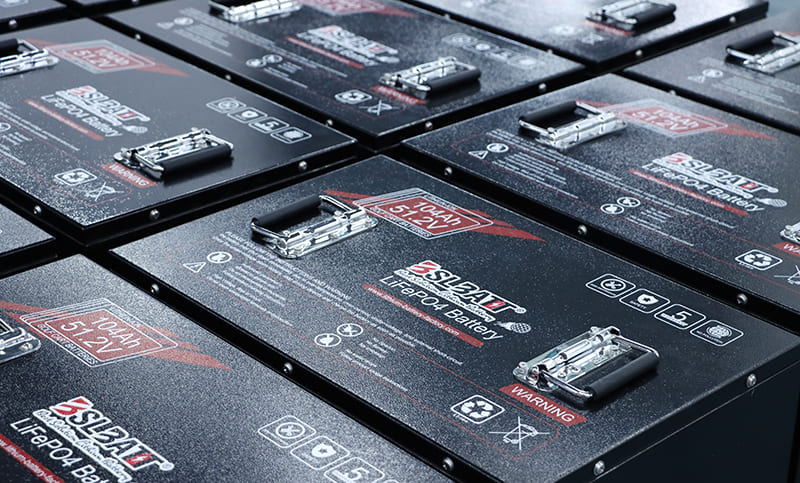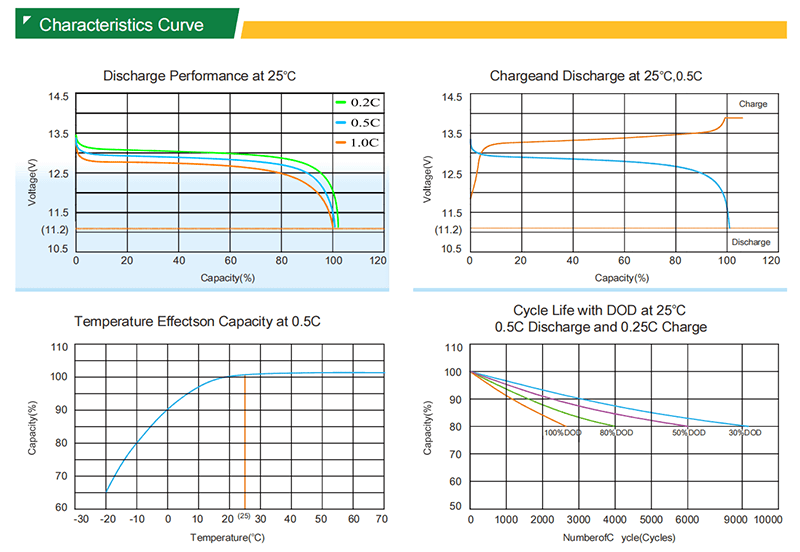Industry Application
Product Type
Lithium Battery Cycle Life: Everything You Need to Konw!
Lithium batteries are widely used in a variety of applications, including consumer electronics, electric vehicles, and renewable energy systems, due to their high energy density and long lifespan. However, like all batteries, lithium batteries have a limited lifespan that is determined by their cycle life – the number of charge and discharge cycles a battery can undergo before its capacity significantly decreases. In this article, we’ll explore the factors that affect lithium battery cycle life, the common causes of lithium battery failure, and some tips and best practices for maximizing the lifespan of lithium batteries.

What is lithium battery cycle life and how is it defined?
Lithium battery cycle life is the number of charges and discharge cycles a battery can undergo before it reaches the end of its useful life. This is typically measured by the number of full charge and discharge cycles a battery can complete before its capacity drops to a specified level, such as 80% of its original capacity. Cycle life is an important consideration for applications that require long-lasting, reliable battery performance.
Factors That Affect Lithium Battery Cycle Life
Lithium battery cycle life is influenced by various factors, including battery chemistry, usage patterns, operating conditions, and maintenance practices. Here are some of the key factors that can impact lithium battery cycle life:
Battery Chemistry: The type of lithium battery chemistry used can significantly impact the cycle life of the battery. Lithium-ion batteries, for example, have a cycle life of around 300-500 cycles, while lithium iron phosphate batteries can last up to 2000 cycles or more.
Usage Patterns: The frequency and depth of discharge cycles can also impact lithium battery cycle life. Frequent deep discharges, where the battery is discharged to a low level, can decrease the battery’s capacity and shorten its lifespan.
Operating Conditions: Extreme temperatures, both high and low, can impact lithium battery cycle life. Exposure to high temperatures can cause the battery to degrade more quickly, while exposure to low temperatures can reduce the battery’s capacity and increase internal resistance.
Maintenance Practices: The way a lithium battery is charged and maintained can also impact its cycle life. Overcharging, for example, can cause the battery to degrade more quickly, while using the wrong charger or charging practices can impact the battery’s performance and lifespan.

Causes of Lithium Battery Failure
Lithium battery failure can be caused by various factors, including overcharging, deep discharging, exposure to extreme temperatures, and physical damage. Here are some of the common causes of lithium battery failure:
Overcharging: Overcharging a lithium battery can cause it to overheat and degrade more quickly. It can also lead to safety issues, such as swelling or even explosion.
Deep Discharging: Frequent deep discharges can reduce the battery’s capacity and shorten its lifespan. It can also cause the battery to become unstable and pose a safety risk.
Extreme Temperatures: Exposure to extreme temperatures can impact the performance and lifespan of lithium batteries. High temperatures can cause the battery to degrade more quickly, while low temperatures can reduce the battery’s capacity and increase internal resistance.
Physical Damage: Physical damage, such as dropping or crushing a lithium battery, can damage the internal components and lead to a shorter lifespan or even failure.
Tips for Maximizing Lithium Battery Cycle Life
To maximize the cycle life of lithium batteries, it’s important to follow some best practices and tips. Here are some tips for maximizing lithium battery cycle life:
Use the Right Charger: Always use the correct charger for your lithium battery, and follow the manufacturer’s recommended charging practices.
Avoid Extreme Temperatures: Try to avoid exposing lithium batteries to extreme temperatures, both high and low. Store them in a cool, dry place and avoid leaving them in hot cars or direct sunlight.
Store at a Lower Charge Level: If you’re not going to use a lithium battery for an extended period, store it at a lower charge level, around 50% charge. This can reduce the chemical reactions that cause capacity loss.
Avoid Deep Discharges: Try to avoid frequent deep discharges, which can reduce the battery’s capacity and lifespan. Instead, aim to keep the battery charged between 20% and 80% of its capacity, and avoid letting it discharge to 0%.
Limit High-Drain Activities: High-drain activities, such as playing games or streaming video, can cause the battery to heat up and degrade more quickly. Try to limit these activities or use them sparingly.
Use Power Saving Modes: Many devices and applications have power saving modes that can help extend battery life. Use these modes whenever possible to reduce battery drain.
Perform Regular Maintenance: Regularly check the battery for any signs of damage or swelling, and clean the battery contacts to ensure good conductivity. If the battery is not performing well, consider replacing it with a new one.
By following these tips and best practices, you can help maximize the cycle life of your lithium batteries and ensure they perform at their best for as long as possible.
What are the different types of lithium batteries and how do they compare in terms of cycle life?
There are several types of lithium batteries available, including lithium-ion (Li-ion), lithium-polymer (Li-poly), and lithium iron phosphate (LiFePO4). Each type of lithium battery has its own unique characteristics, including differences in cycle life.
| Lithium Battery Type | Typical Cycle Life |
| Lithium-Ion (Li-ion) | 300-500 cycles |
| Lithium-Polymer (Li-poly) | 500-700 cycles |
| Lithium Iron Phosphate (LiFePO4) | 3000-6000 cycles |
| Lithium Titanate Oxide (LTO) | 15000 cycles or more |
| Lithium Manganese Oxide (LiMn2O4) | 1000-2000 cycles |
| Lithium Nickel Cobalt Aluminum Oxide (NCA) | 300-500 cycles |
| Lithium Nickel Manganese Cobalt Oxide (NMC) | 500-1000 cycles |
Li-ion batteries are commonly used in portable electronics and have a typical cycle life of 300-500 cycles. Li-poly batteries have a slightly longer cycle life of around 500-700 cycles and are often used in thin and light devices. LiFePO4 batteries have a much longer cycle life of around 3000-6000 cycles and are commonly used in electric vehicles and energy storage systems.
It’s important to note that cycle life can vary based on several factors, including temperature, charging and discharging rates, and depth of discharge. Proper battery management and maintenance can also help extend the cycle life for all types of lithium batteries.
What are some real-world applications of lithium batteries and how does cycle life impact their performance?
Lithium batteries are used in a wide range of applications, from portable electronics to electric vehicles and renewable energy systems. In these applications, cycle life can have a significant impact on battery performance and overall system efficiency.
For example, in electric vehicles, a battery’s cycle life directly impacts its range and performance. A battery with a shorter cycle life will need to be replaced more frequently, increasing maintenance costs and reducing overall efficiency. In renewable energy systems, such as solar or wind power, battery cycle life is critical for storing and utilizing energy efficiently. A battery with a longer cycle life can help maximize energy output and reduce system downtime.
Understanding the impact of cycle life on battery performance is essential for selecting the right type of lithium battery for your specific application and ensuring optimal performance over the battery’s lifetime.
In conclusion, lithium battery cycle life is a critical factor to consider when using lithium batteries in various applications. Understanding the factors that impact cycle life, the common causes of battery failure, and tips for maximizing battery lifespan can help you make informed decisions about how to use and maintain your lithium batteries. By taking care of your lithium batteries and following best practices, you can help ensure they last as long as possible and provide reliable performance for your needs.
A Guide to Choosing the Best 48V Lithium Golf Cart Battery
Would it be worth investing in a 48V ...
10 Exciting Ways To Use Your 12V Lithium Batteries
Back in 2016 when BSLBATT first began designing what would become the first drop-in replacemen...
BSLBATT Battery Company Receives Bulk Orders from North American Customers
BSLBATT®, a China Forklift battery manufacturer specializing in the material handling indust...
Fun Find Friday: BSLBATT Battery is coming to another great LogiMAT 2022
MEET US! VETTER’S EXHIBITION YEAR 2022! LogiMAT in Stuttgart: SMART – SUSTAINABLE – SAF...
Looking for new Distributors and Dealers for BSL Lithium Batteries
BSLBATT battery is a fast-paced, high-growth (200% YoY ) hi-tech company that is leading the a...
BSLBATT to Participate at MODEX 2022 on March 28-31 in Atlanta, GA
BSLBATT is one of the largest developers, manufacturers, and integrators of lithium-ion batter...
What makes the BSLBATT the Superior Lithium Battery for your Motive Power needs?
Electric forklift and Floor Cleaning Machines owners who seek the ultimate performance will fi...





























